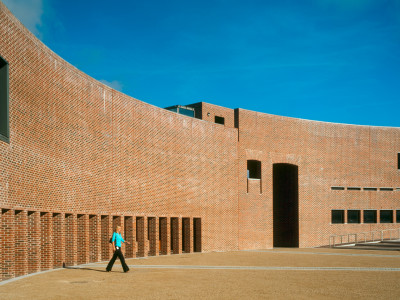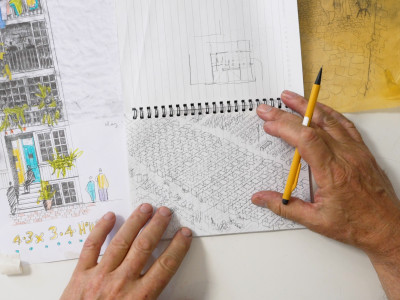
12 mavericks of architecture
By Helena Cuss
Published on 25 January 2016
From championing ground-breaking styles of architecture to famously abandoning commissions before completion, these British architects broke the mould. Meet the mavericks, as our new architecture display goes on show.
This Spring, we’re discussing the British architects who defy convention and stand outside the mainstream – with a book, an installation and a series of events. Through their visionary and often groundbreaking practice, these 12 have helped shape British architecture since the 16th century. Here's what you need to know.
Robert Smythson (c. 1535–1614)
Smythson is one of the earliest practitioners who can be called an architect; working as a master stonemason when the architectural profession was in its infancy, he rose to prominence for his work on Longleat House in Wiltshire, and went on to design a number of Elizabethan country houses in which he pioneered a sophisticated conflation of classical proportions with the British Gothic tradition. His masterpiece, Hardwick Hall in Derbyshire, has unusually large windows for its time, when glass was a luxury.
John Vanbrugh (1664–1726)
Vanbrugh’s tour de force and most famous building is the resplendent Blenheim Palace, one of the key works of the English Baroque style, referencing the visual language of sources ranging from medieval and Elizabethan architecture to Italian Mannerist architect Palladio. A man of many talents, he was also a controversial Restoration dramatist, writing plays that defended women’s rights in marriage and which shocked audiences with their sexual explicitness.
James Wyatt RA (1746–1813)
James Wyatt was unusual for working in both the neoclassical and neo-Gothic styles. His greatest work is generally considered to be the Pantheon, a now-destroyed public entertainment hall on Oxford Street in London, which was modelled on the Pantheon in Rome. Despite his disorganised approach to commissions, which he frequently abandoned before completion, he managed to become President of the Royal Academy for one year, never to be re-elected.



William Hodges and William Pars, The Pantheon, Oxford Street, London , 1770–72
John Soane RA (1753–1837)
Soane is best remembered today for his extraordinary labyrinthine house-museum in London, which houses his life’s collection of paintings, drawings and antiquities, as well as drawings and models of his own projects. However, his greatest work was at the Bank of England which he transformed in the classical style, with a series of ethereal domed spaces.
Charles Robert Cockerell RA (1788–1863)
An archaeologist as well as an architect, Cockerell’s fascination with Greek architecture blossomed during his Grand Tour in 1910 to Italy, Greece and Turkey. Unusually for a Victorian architect, he had an eclectic approach to architectural style, embracing both Neoclassicism and the Gothic, but the classical influence is clearly seen in the Ashmolean Museum which he built in 1845. Such was his reputation as an architect that he was buried next to Sir Christopher Wren in St Paul’s Cathedral.
Charles Rennie Mackintosh (1868–1928)
Mackintosh’s unique architectural aesthetic was a direct result of his profound feel for materials, interwoven with decorative elements that were fundamental to the building’s form. This found full expression in his most ambitious unbuilt projects such as Liverpool Cathedral, but can also been seen in the beloved Glasgow School of Art, which suffered major fire damage in 2014.

Bank of England, London: Colonial Office (1818–23), by Sir John Soane,

The Professor’s Dream, 1848

Glasgow Herald Building: perspective, 1894–5
Charles Holden (1875–1960)
A modern architect, though not a Modernist, working primarily in the 1920s and 30s, Holden spurned popular Art Deco ornamentation for a simplified, functional architecture which found full expression in his monumental Senate House building for the University of London. He is best known, however, as the architect of many London Underground stations, particularly along the Piccadilly line.
H. S. Goodhart-Rendel (1887–1959)
It is difficult to pin Goodhart-Rendel down to one architectural style; he was a proponent of neither Modernism, Art Deco, classical or Gothic but had a uniquely personal aesthetic which differed with each building, depending on the commission, many of which were churches. His design for St Olaf’s House which fronts onto the River Thames in central London reflected its use as a headquarters for an industrial company, using a stripped back functional aesthetic.
James Stirling RA (1926–1992)
One of the most influential architects of the mid-late 20th century, Modernist, Brutalist and Postmodernist James Stirling still splits opinion for his experimental designs, even after his untimely death at the age of 66. His work is defined by its complex geometrical compositions with innovative materials. His last building was also one of his most controversial: No. 1 Poultry, with its bold Postmodernist use of shape and colour was completed as the tide of critical opinion was turning away from that style, in 1997.
Cedric Price (1934–2003)
A maverick in the most literal sense, few of Price’s projects were ever realised, but had an enormous impact on the subsequent generation of architects, often his pupils. His best-known design, the Fun Palace – a flexible model for a new type of cultural facility – was never built, due to the complexity of a structure in which almost everything was moveable. Despite its incompletion, it was cited by Renzo Piano and Richard Rogers as a major influence on the Centre Georges Pompidou in Paris. One structure he has left behind is the Snowdon Aviary at London Zoo, completed in 1961.
FAT (active 1995–2013)
Fashion Architecture Taste was formed by architects Sean Griffiths, Charles Holland and Sam Jacobs in the 1990s as an antidote to what they perceived as a restrictive architectural orthodoxy at that time. Their final work, before disbanding in 2013, was A House for Essex, a holiday home-cum-work of art conceived in partnership with artist Grayson Perry RA, which draws on follies and fairy tales to offer the visitor an uniquely eccentric experience.
Zaha Hadid RA (b. 1950)
An architect of international standing, Hadid has developed a futuristic style of fluid, curving forms which make her buildings instantly recognisable the world over. The spectacular Heydar Aliyev Cultural Centre in Azerbaijan encapsulates her dynamic approach to a building’s design and construction, and she remains the only woman to have won the Pritzker Prize, architecture’s most prestigious prize.
Who else should be on the list? Tell us below or tweet with #MaverickArchitects.
Mavericks: Breaking the Mould of British Architecture is at the RA from 26 January to 20 April.
Related articles

Crunch: inside the first Architecture Window display
14 February 2024

RA Architecture Prize Winner 2023: Shane de Blacam
1 September 2023






